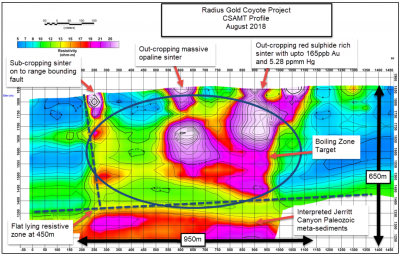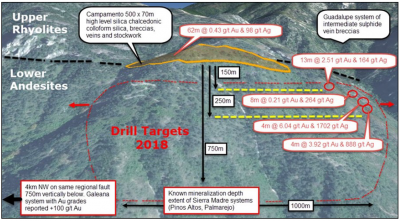
Vancouver, Canada: Radius Gold Inc. (TSX-V: RDU) is pleased to announce mobilization of a drill team to explore Radius’s high-grade gold-silver Amalia Project located in Chihuahua, Mexico. The drill program, operated by Radius and funded by Pan American Silver, is expected to commence in September. Radius is also pleased to announce it has completed a large detailed CSAMT geophysical survey, geological mapping and geochemical sampling at its 100% owned Coyote hot-springs epithermal gold project near Elko, Nevada and is on track to commence Radius-funded drilling this season at Coyote.
Amalia Project
The 9450 hectare Amalia Project is located 25 km SW of the historic Guadalupe y Calvo mining district in Chihuahua. Radius geologists discovered high grade epithermal silver-gold mineralization in several veins, vein breccias and disseminated zones over 3.5km of strike length and a 600m vertical interval following the trace of a large regional fault zone. An agreement to explore Amalia Project with Pan American Silver Corp. was announced 30th July 2018 and Radius has since upgraded the camp to accommodate a drilling team, and mobilized machinery to upgrade roads and build drill platforms. Management expects to commence drilling in September on multiple drill targets, including Campamento, Guadalupe and Dulces (see press release dated July 30th, 2018, and target details and Figure 2 below).
Coyote Project
On March 21, 2018, Radius announced an agreement to acquire a 100% interest in the Coyote gold property in Elko County, Nevada. The Coyote Project is located in a world class gold producing district near the intersection of the prolific Carlin trend (estimated 90Moz gold production since 1965) and the Independence trend (estimated 8Moz gold production since 1981).
In the last 3 months Radius completed at Coyote a 295 station CSAMT geophysical survey covering roughly 1.5km2 and combined soil geochemical and property wide geological mapping. The results of this work have defined compelling drill targets where co-incident rock and soil geochemical gold-antimony-arsenic-mercury anomalies occur within a surficial sinter hot spring environment. The CSAMT survey shows a large and coherent (950m by 250m) strongly resistive zone adjacent to and below the surface sinter that extends from surface to the bottom of the geophysical survey at 600m depth and is predicted to represent a sheeted vein system.
The main drill targets are the boiling zone estimated 200m below the surface sinters and where the system transitions from the Tertiary upper volcanic host rocks into the Jerritt Canyon Paleozoic meta-sediments (host of the 8Moz gold production from the Independence trend). The recent discovery of the Gravel Creek Gold-Silver Deposit (see note 1) by Western Exploration approximately 45km north of Coyote is an excellent analog where a hot spring sinter environment, anomalous geochemistry and geophysical programs led Western Exploration to target the Tertiary-Paleozoic boundary beneath the system with deep drilling resulting in discovery holes including;
WG373 from 470m to 762m with 291m at 13.52 g/t Au, and
WG374 from 457m to 646m with 189m at 34.6 g/t Au
With compelling drill targets defined (figure 1) at Coyote, Radius expects to have drill permission in the coming weeks and drill testing the targets at Coyote to commence before the snow arrives in Nevada.

Amalia Drill Targets
An initial 2000m diamond core drill program is planned at Amalia to test a minimum of three targets:
1) Campamento target is a 500m x 70m zone of intense silicification and brecciation with massive and stockwork veining. A chip channel (Radius news Sept 19, 2017) across the middle of Campamento graded 62m at 0.43 g/t Au and 98 g/t Ag from 30 continuous rock chip samples. In March 2018, Radius reported high grade zones at Campamento including a continuous rock chip channel assaying 4.5m at 10.3 g/t Au and 202 g/t Ag. The exposed Campamento system is Rhyolite hosted, high level banded chalcedonic silica veins and breccias. Radius and Pan American plan to initially test 100m to 250m below Campamento where mineralization is expected to transition to andesite hosted higher grade sulphide rich breccias as exposed along strike and deeper in the system at Guadalupe target.
2) Guadalupe target is a high grade andesite hosted structurally controlled breccia zone that outcrops 450m south along strike from Campamento and 250m lower in the geological section. Guadalupe sampling includes the previously published (Radius news Sept 19, 2017) continuous rock chip results: Guadalupe shaft - 7m at 3.62 g/t Au and 1048 g/t Ag, and Guadalupe tunnel - 4m at 3.92 g/t Au and 888 g/t Ag.
3) Dulces target is located 800m NE of Campamento, at similar elevation. The poorly exposed Dulces vein occurs within an extensive area of argillic altered andesite volcanics and related gold in soil anomaly. The main vein varies from 1 to 1.5m wide and with chip samples returning: 1m at 34 g/t Au and 13 g/t Ag and 1.5m at 114.5 g/t Au and 57 g/t Ag (Radius news Sept 19, 2017).
Geologically similar gold-silver epithermal deposits of the Sierra Madre belt have mineralization defined over a vertical interval of 600 to 700m. The transition from upper rhyolite hosted mineralization into higher grade andesite host at depth is commonly observed. Radius and Pan American plan drilling to target high grade mineralization at depth below the Campamento silica zone and at the Guadalupe and Dulces targets (Figure 2).

The Pan American Agreement
Radius has granted to Pan American Silver Corp. the option to earn up to an initial 65% interest in the Amalia Project by making cash payments to Radius totaling US$1.5 million (of which US$100,000 has been received) and expending US$2 million on exploration over four years. Pan American may earn an additional 10% by advancing the property to preliminary feasibility. Initially Radius will be the project operator.
Spring Peak Project
Radius completed a CSAMT geophysical survey, soil geochemistry and mapping at the Spring Peak project in Nevada. After evaluation of the data, Radius has terminated the option agreement and returned the project to the owners.
Technical Information
Bruce Smith, M.Sc. (Geology), a member of the Australian Institute of Geoscientists, is Radius’s Qualified Person as defined by National Instrument 43-101 - Standards of Disclosure for Mineral Projects. Mr. Smith participated in the reported programs and prepared and approved the technical information contained in this news release.
Note 1. Information on the Gravel Creek Gold-Silver Deposit was published in New Concepts and Discoveries: Geological Society of Nevada 2015 Symposium, O.D Christensen and J.G. Cleary. Geology and Discovery History of the Gravel Creek Silver-Gold Deposit, Elko County, Nevada.
Radius Gold Inc.
Radius has a portfolio of projects located primarily in the United States and Mexico which it continues to advance, utilizing partnerships where appropriate in order to retain the Company’s strong treasury. At the same time, management is seeking out additional investment and project acquisition opportunities across the globe.
ON BEHALF OF THE BOARD
Simon Ridgway
President and CEO
Symbol: TSXV-RDU
Contact: Simon Ridgway
200 Burrard Street, Suite 650
Vancouver, BC V6C 3L6
Tel: 604-801-5432; Toll free 1-888-627-9378; Fax: 604-662-8829
Email: info@goldgroup.com
Website: www.radiusgold.com
Neither the TSX Venture Exchange nor the Investment Industry Regulatory Organization of Canada accepts responsibility for the adequacy or accuracy of this release.
Forward-Looking Statements
Certain statements contained in this news release constitute forward-looking statements within the meaning of Canadian securities legislation. All statements included herein, other than statements of historical fact, are forward-looking statements which include, without limitation, statements about the possible acquisition by Pan American of an interest in the Amalia Project; the exploration plans for the Amalia Project and Coyote Project; the Company’s business strategy, plans and outlook; the merit of the Company’s investments and properties; timelines; the future financial performance of the Company; expenditures; approvals and other matters. Often, but not always, these forward looking statements can be identified by the use of words such as “estimate”, “estimates”, “estimated”, “potential”, “open”, “future”, “assumed”, “projected”, “used”, “detailed”, “has been”, “gain”, “upgraded”, “offset”, “limited”, “contained”, “reflecting”, “containing”, “remaining”, “to be”, “periodically”, or statements that events, “could” or “should” occur or be achieved and similar expressions, including negative variations.
Forward-looking statements involve known and unknown risks, uncertainties and other factors which may cause the actual results, performance or achievements of the Company to be materially different from any results, performance or achievements expressed or implied by forward-looking statements. Such uncertainties and factors include, among others, the possible acquisition by Pan American of an interest in the Amalia Project; the plans for exploring the Amalia Project and Coyote Project; changes in general economic conditions and financial markets; the Company or any joint venture partner not having the financial ability to meet its exploration and development goals; risks associated with the results of exploration and development activities, estimation of mineral resources and the geology, grade and continuity of mineral deposits; unanticipated costs and expenses; and such other risks detailed from time to time in the Company’s quarterly and annual filings with securities regulators and available under the Company’s profile on SEDAR at www.sedar.com. Although the Company has attempted to identify important factors that could cause actual actions, events or results to differ materially from those described in forward-looking statements, there may be other factors that cause actions, events or results to differ from those anticipated, estimated or intended.
Forward-looking statements contained herein are based on the assumptions, beliefs, expectations and opinions of management, including but not limited to: that Pan American will acquire an interest in the Amalia Project; that the exploration activities at the Amalia Project and Coyote Project will proceed as planned; that the Company’s activities will be in accordance with its public statements and stated goals; that all required approvals will be obtained; that there will be no material adverse change affecting the Company or its investments or properties; and such other assumptions as set out herein. Forward-looking statements are made as of the date hereof and the Company disclaims any obligation to update any forward-looking statements, whether as a result of new information, future events or results or otherwise, except as required by law. There can be no assurance that forward-looking statements will prove to be accurate, as actual results and future events could differ materially from those anticipated in such statements. Accordingly, investors should not place undue reliance on forward-looking statements.
